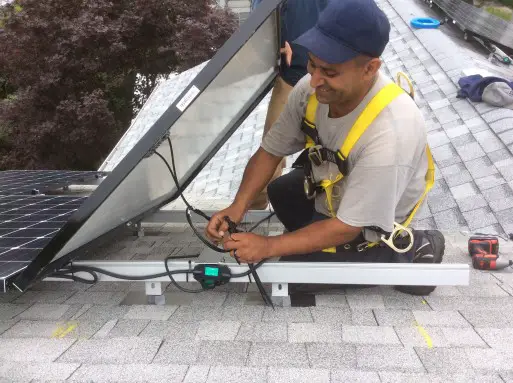Off-grid energy systems for homes are getting more popular all the time, and photovoltaic solar panels are one of the most fascinating developments in the world of alternative energy because they seem so much like magic. A flat, grey panel sits in the sun and makes electricity. No noise, no exhaust, no moving parts. A growing number of people are wondering how this technology might be incorporated into their homes, and the information you’ll find here is the first step towards an answer. It comes from my online course POWER YOUR HOME WITH RENEWABLE ENERGY.
See what they’re saying about the course. . .
“Now that I’ve had the chance to go through your entire off-grid energy course, I’ll again say . . . I find it easy to read, packed with helpful information, and overall a nice package that’s definitely worth the money. Thanks again for putting this together.” – CG
“Thanks for a good introduction to PV systems! I really enjoyed the class. So much so that I’m now registered for a Midwest Renewable Energy Assn PV101 class and will go on to get my PV Associate Certification! Your class has given me a stepping stone to the more technical aspects of PV work.” – HJ
“Thank you so much for your time and effort in putting this course together. I found it not only helpful but interesting!” – MH
++++++++
Before I explain the three different ways photovoltaic solar panels can be used, watch the video below for an overview of off-grid energy systems, and see how solar panels fit into the mix.
Sunlight shines on photovoltaic (PV) panels and the light energy is converted to electricity. That’s step one of the process. This electricity is typically stored for future use in a battery. Storage is step two. You can also convert solar-generated electricity into the form that typically comes out of a wall socket. That’s optional conversion step number three.
Here are more details:
All photovoltaic panels are rated by how much power flows from them while the sun shines, expressed in watts (W). A panel putting out 500 W, for instance, can power up to five 100 W light bulbs at one time. Panels that generate 1000 watts of power are making one kilowatt of electricity.

The electricity that comes directly from PV panels is called direct current (DC). This is also the kind of energy put out by every battery in the world. The term DC refers to the fact that this electricity flows in one direction only, across the positive and negative poles of a battery or pair of wires. Photovoltaic panels only create direct current, and though this kind of electricity certainly has its uses, it’s not the kind of power that most electrical appliances are designed to accept. Typical electrical devices are made to use something called alternating current (AC). The 120 volt AC power that comes out of wall outlets across North America oscillates back and forth from positive to negative polarity 60 times each second. Other parts of the world have an alteration rate of 50 times per second. With this basic information in hand, you have what you need to understand the three main photovoltaic options.
- Simple DC-Only Systems: An array of PV panels charges batteries that deliver power to items requiring DC current only. This is most often light bulbs, but DC water pumps and refrigerated coolers also exist.
- DC-AC Systems: This option also has PV panels and a battery, but they’re connected to something called an inverter. This is an electronic device that converts the DC electricity from batteries into the kind of 120-volt AC power that most of our gizmos are designed to use. Inverters are a great thing, though they do introduce some inefficiency into the system. All else being equal, power is lost in the conversion process, so you really want to be sure that you need AC power before you introduce an inverter into the set up.
- DC-AC Grid-Connected System: This builds on the DC-AC system, with one important difference. In addition to converting DC power to 120 volts AC, this system is connected to, and synchronized with, the local utility power grid. When you’re making more power than you consume, for instance, it runs your electrical meter backwards, reducing the amount of power you’re charged for. Some places offer electricity buy-back rates high enough to make grid-connected PV systems a paying proposition. I know a number of people who pay nothing each month for grid power, yet consume quite a bit of it. They’re use is offset by their own home production of power.
These are the fundamental concepts that apply to the world of photovoltaics, regardless of the state of the technology. At this stage of the technology’s development, it’s easier than ever to find and assemble all the parts needed for your own system., the best way for most people to make PV part of their lives does not necessarily involve choosing and installing each component from scratch. Unless you’re heavily into tinkering, it’s best for you to consider a pre-packaged PV system where all components are engineered to work together. At least now you know the basics of the options that are available, and that’s a good thing. It’s only a matter of time before photovoltaics become mainstream.



